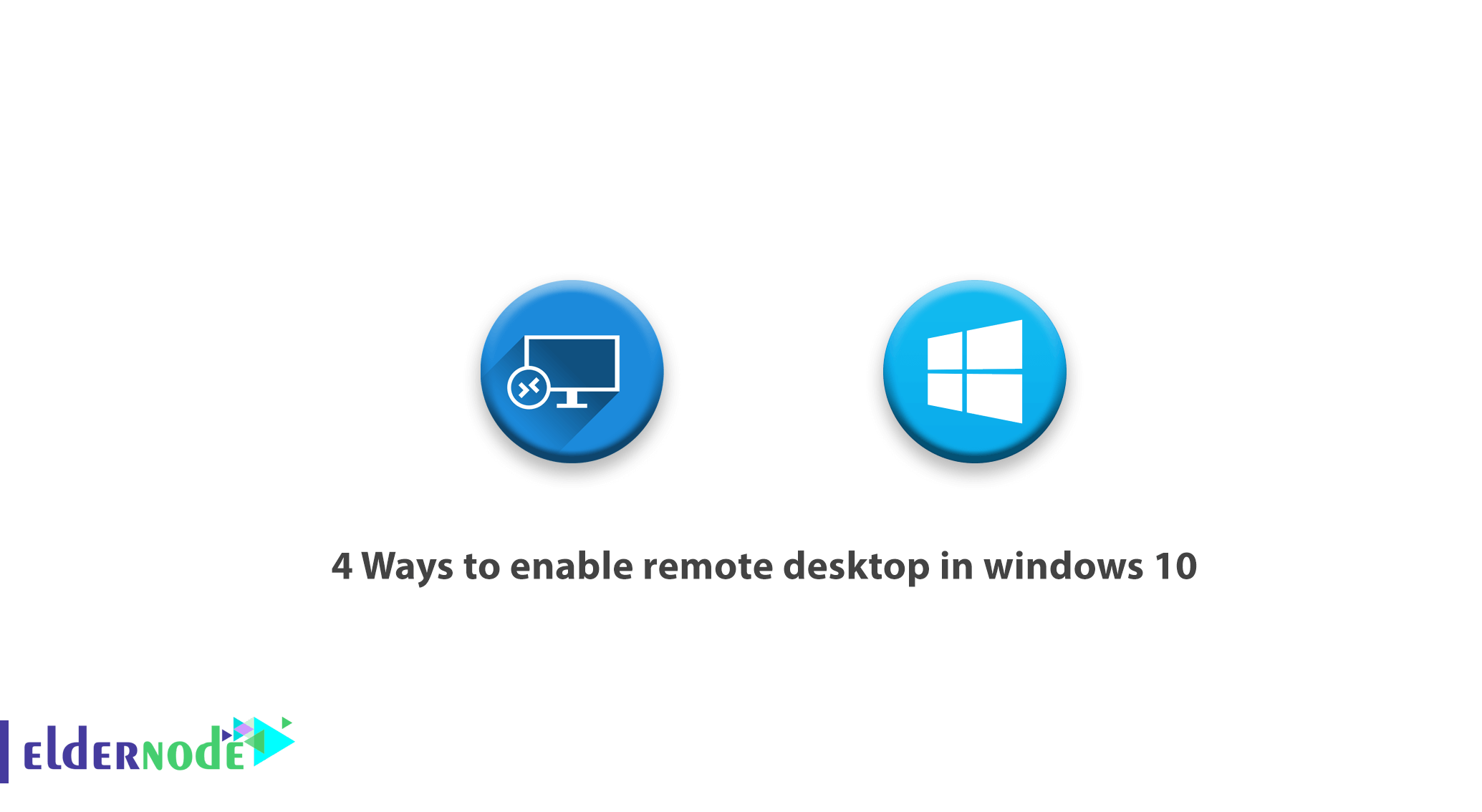
You are definitely in a situation where you need to check, install software, support and various services on one computer and that system is far away from you and may even be in another city. Therefore, you do not have physical access to it. In this article, we want to introduce you to 4 Ways to enable remote desktop in windows 10 which includes Group Policy, PowerShell, WMI, and so on.
Even the most expert and so-called Geek people in the Windows operating system sometimes need to go to the Remote Desktop system and manage it. As someone who works professionally with Windows operating system, you definitely know that you can enable Remote Desktop in Windows through System Properties. In fact, this is the easiest and most accessible way. But if you want to run a remote system on the Remote Desktop network, you must first enable Remote Desktop on that system because for security reasons, this feature is disabled in Windows by default. There square measure several RDP Admin Server services on the market at Eldernode. You can choose one of the plans.
Table of Contents
4 Ways to enable remote desktop in windows 10
Remote Desktop capability is one of the functional features of Windows. The purpose of remote desktops is to enable people to connect remotely to other computers. If you are a Windows 10 user and you want to use this feature, join us. To learn Remote Desktop in Windows 10, you need to make changes to your computer settings. Here are four ways to allow your computer to accept this connection.
1. Enable Remote Desktop via Group Policy Object or GPO
To do this, open the Group Policy management console and go to the following path:
Computer Configuration > Administrative Templates > Windows Components >Remote Desktop Services > Remote Desktop Session Host > Connections Double-click Allow users to connect remotely using Remote Desktop Services and Enable it.
Now you need to specify the range of IP addresses that can access the Remote Desktop remote system.
Go to the following path first:
Computer Configuration > Policies > Administrative Templates > Network > Network Connections > Windows Firewall > Domain Profile Double-click the Windows Firewall: Allow inbound Remote Desktop exceptions policy and Enable it. Then enter the desired IP addresses in the IP range box.
2. Activate Remote Desktop via PowerShell
Activating Remote Desktop via PowerShell is a bit difficult.
First, PowerShell Remoting must be enabled on the destination system to be able to manage client and server systems by PowerShell. We assume that PowerShell Remoting is active on the destination system. Now you can activate Remote Desktop on the destination system by executing the following command:
Invoke-Command -Computername -ScriptBlock {Set-ItemProperty -Path "HKLM:\System\CurrentControlSet\Control\Terminal Server" -Name "fDenyTSConnections" –Value 0 } Instead of Computername, you need to enter the destination computer name. We used Invoke-Command to use the Set-ItemProperty command. This command changes the value of the fDenyTSConnections registry key to zero.
Most likely, the Windows Firewall will block RDP traffic, so you must use the following command to allow RDP traffic to enter the destination system:
Invoke-Command -Computername -ScriptBlock {Enable-NetFirewallRule -DisplayGroup "Remote Desktop"} 3. Enable Remote Desktop via WMI
If PowerShell Remoting is not enabled on the destination system, you can still use PowerShell via WMI. This method can be useful when you want to enable RDP on a large number of clients. Using the following script, you can manage PowerShell Remoting on destination systems without activating it.
[cmdletbinding()] param( [parameter(ValueFromPipeline=$true,ValueFromPipelineByPropertyName=$true)] [string[]]$ComputerName = $env:computername, [ValidateScript({Test-Path $_})] [string]$OutFolder = "c:\" ) begin { $SuccessComps = Join-Path $OutFolder "Successcomps.txt" $FailedComps = Join-Path $OutFolder "FailedComps.txt" } process { foreach($Computer in $ComputerName) { try { $RDP = Get-WmiObject -Class Win32_TerminalServiceSetting ` -Namespace root\CIMV2\TerminalServices ` -Computer $Computer ` -Authentication 6 ` -ErrorAction Stop } catch { Write-Host "$Computer : WMIQueryFailed" "$Computer : WMIQueryFailed" | Out-File -FilePath $FailedComps -Append continue } if($RDP.AllowTSConnections -eq 1) { Write-Host "$Computer : RDP Already Enabled" "$Computer : RDP Already Enabled" | Out-File -FilePath $SuccessComps -Append continue } else { try { $result = $RDP.SetAllowTsConnections(1,1) if($result.ReturnValue -eq 0) { Write-Host "$Computer : Enabled RDP Successfully" "$Computer : RDP Enabled Successfully" | Out-File -FilePath $SuccessComps -Append } else { Write-Host "$Computer : Failed to enabled RDP" "$Computer : Failed to enable RDP" | Out-File -FilePath $FailedComps -Append } } catch { Write-Host "$computer : Failed to enabled RDP" "$Computer : Failed to enable RDP" | Out-File -FilePath $FailedComps -Append } } } } end {} Save this script in a file with the suffix ps1.
For example, we name this file Enable-RDPAccess.ps1. Now run the following command:
.\Enable-RDPAccess.ps1 -ComputerName Instead of ComputerName, you need to enter the destination computer name. If you want to enable RDP on a large number of client systems, save the computer names of the systems in a text file and run the following command:
Get-Content | Enable-RDPAccess.ps1 By executing the following command, you can also allow RDP traffic to enter the destination system:
wmic /node: process call create "cmd.exe /c netsh firewall set service RemoteDesktop enable" You can also use the wmic tool to enable Remote Desktop on clients:
wmic /node: process call create 'cmd.exe /c reg add "HKEY_LOCAL_MACHINE\SYSTEM\CurrentControlSet\Control\Terminal Server" /v fDenyTSConnections /t REG_DWORD /d 0 /f' Note that in the firewall settings of the remote system, you must allow WMI traffic to enter. You can do this using Group Policy. To do this in Group Policy, go to the following path:
Computer Configuration > Policies > Windows Settings > Security Settings > Windows Firewall with Advanced Security Right-click on Inbound Rules and select Predefined and select Windows Management Instrumentation or WMI from the Drop-Down menu.
4. Activate Remote Desktop via PsExec
Another option that can be used to enable Remote Desktop on client systems is to use the free PsExec tool. Using this tool does not require activating PowerShell Remoting on remote systems. The only downside to this tool is that it’s not as easy to use as the Invoke-Command in PowerShell. To use PsExec, File and Printer sharing in the remote system must be open to Inbound. That’s likely to be more open than WMI ports or PowerShell Remoting. If it is not active, you can activate it in Group Policy from the following path:
Computer Configuration > Policies > Administrative Templates > Network > Network Connections > Windows Firewall > Domain Profile > Windows Firewall: Allow inbound file and printer sharing exception Now go to the folder where the psexec.exe tool is located and then run the following command in the Command Prompt:
psexec.exe \\ reg add "HKEY_LOCAL_MACHINE\SYSTEM\CurrentControlSet\Control\Terminal Server" /v fDenyTSConnections /t REG_DWORD /d 0 /f Using the following command, you must allow RDP traffic to enter the destination system:
psexec.exe \\ netsh firewall set service RemoteDesktop enable Conclusion
The RDP protocol allows users to remotely access the desktop and applications within it. In fact, you can remotely access servers within the Remote Desktop organization and work with applications within it. In this article, we taught you how to activate the Remote Desktop in Windows 10 with 4 methods, which are GPO, PowerShell, WMI and PsExec.





What are the solutions to increase the security of the remote desktop?
– Network Level Authentication (NLA)
– Block 3389 TCP port on the network used and change the RDP port
What is required to use the Remote Desktop service?
– Computers do not have a problem in terms of network.
– Because Firewall closes input ports by default, including 3389, which is related to Remote Desktop, then the Firewall must be turned off. Or it spent the desired port from Block mode.
– Remote permission must be issued by the destination computer.
What is the solution to the problem of remote desktop not connecting to the CredSSP remote desktop virtual server?
For this, open cmd as window as Administrator and enter the following command:
REG ADD HKLM\Software\Microsoft\Windows\CurrentVersion\Policies\System\CredSSP\Parameters\ /v AllowEncryptionOracle /t REG_DWORD /d 2
How is it possible to find a public IP?
You can easily find it by opening the browser and searching for what is my ip.
What are the differences between Remote Desktop Connection and Remote Desktop?
Both programs have the same capabilities. The new Remote Desktop app is compatible with the new Windows design and is available on all platforms including desktop, Windows Mobile, Android, iPad, iPhone and Mac.